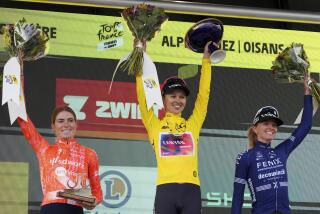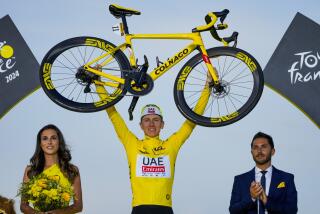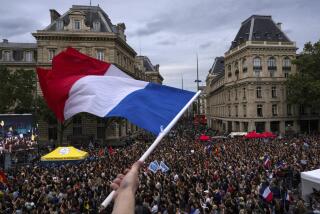Tour De Excess
JAUNAY-CLAN, France — Julie Valee is riding in this year’s Tour de France. Not on a bicycle, though. The 22-year-old in a red microskirt and white T-shirt stretches from a car, handing out small Camembert cheeses to an often frenetic crowd.
“We finish the Tour with scratches all over our hands and arms,” the blond Frenchwoman says. “We don’t wear bracelets or rings, because people could hurt us or themselves when they try to grab a sample.”
Imagine the Super Bowl, Home Shopping Network and state fair rolled into one and on the move for 21 consecutive days and you’ll have a fair idea of the hokum and hoopla of the Tour, the world’s premier bicycle race now snaking its way across France.
Forget for now defending champion Lance Armstrong of the Unites States, in 12th place (but with two weeks of racing still ahead, and the hardest stages yet to come). The Tour de France is also:
* A mobile city of more than 3,000, complete with its own post office, medical corps and masseurs, police station, headquarters, printing press, grandstands and winner’s podium. Like a nomad camp, the Tour dismantles and reassembles itself every night for three weeks to stay ahead of the race.
* An “advertising caravan” of 220 vehicles that precede the cyclists, with cars dressed up like giant wrist watches, jars of pork pate, bags of marshmallows, demitasses of coffee and other consumer products.
* Enough police to guard a summit of world leaders. To control crowds and block roads for the passage of the Tour through only one typical rural departement of France, 1,270 gendarmes were mobilized for three days last week.
* A total of 1,790 accredited journalists and media technicians, as well as mobile TV and radio studios and darkrooms. There are cameramen specialized in the difficult art of shooting the race from the backs of speeding motorcycles or from helicopters, and an announcer at the start and finish, Daniel Mangeas, who has total recall of each cyclist’s career.
The Tour on the road, with its fleet of 1,500 trucks, cars and motorcycles, is a sight more akin to the passing of an armored division than a bike race. Each summer, about 15 million of the French watch it rumble by, along with the cyclists.
In provincial towns such as Nantes, Tours or Revel, huge throngs assemble to witness what will be the biggest local happening of the year. People chow down on spicy merguez sausage and other delicacies sold by the swarm of vendors accompanying the race. Spectators eagerly await the arrival of the riders--and the freebies.
“People are so eager to get something from us, they’re ready to jump in our cars,” says Valee, working her third Tour for the Coeur de Lion brand of Camembert. To prevent riots, workers in the caravan aren’t allowed to throw samples into the crowd.
By the time this year’s Tour finishes on the Right Bank of Paris on July 23, the 600 people employed in the advertising convoy will have doled out 20 million free items to spectators, from sausages and pate on toast to plastic cups of hot coffee.
As well as a sporting event and national institution, the Tour is a business. Its owner, Editions Amaury, also publishes L’Equipe, the national sports daily, and Le Parisien, a tabloid newspaper. In February, the group took over management of the Futuroscope theme park near Poitiers, which, not coincidentally, was the kickoff point for the 2000 Tour.
Not all of the French love cycling, but like everyone else, they like getting something for nothing. A poll taken for the Tour has revealed that more spectators actually enjoy the advertising caravan, 47%, and the event’s carnival-like ambience, 43%, than the race itself, 37%.
“Above all, the caravan has to be seen by the public as a huge party,” said Jean-Pierre Lachaud, in charge of the advertising cavalcade, which stretches for 15 miles and usually takes 45 minutes to pass. “But for the companies that take part, it also must be a fantastic communications medium.”
To get three vehicles in the caravan, a company pays $18,500. Some of the biggest guns of global business have dished out even larger, undisclosed sums to obtain the status of Tour “partner.”
For instance, Credit Lyonnais, a French bank, has bought the right to plaster its name on the yellow jersey worn by the cyclist with the best overall time. Fiat, the Italian auto maker, paints its logo on the homestretch asphalt near each day’s finish line. Coca-Cola has arranged for the winners of each day’s stage to receive a special prize: a gilded Coke bottle in a Lucite ring.
The 20 teams competing in the Tour are an integral part of such full-blooded commercialism. They are financed by businesses, from a Dutch manufacturer of frozen French fries to an Italian glue maker. On the blue outfits worn by Armstrong and his U.S. Postal Service teammates are the logos of no fewer than nine sponsors.
“We sell every square inch--are you kidding?” said Margot Myers, spokeswoman for U.S. Postal.
For France’s cities and towns, hosting the race is a privilege to be purchased, in exchange for the tourist influx and media exposure the event hopefully will bring. Elected officials in the Vienne, a largely rural area of west-central France, shelled out nearly $1 million to Tour organizers to host the first 2 1/2 days of this year’s race.
“The return on investment is inestimable,” said Jerome Neuveux, a spokesman for the local government. “Try to calculate what it would cost to put a commercial about the Vienne on television in 169 countries, which is how many have TV coverage of the Tour.”
Loudun, a town of 8,200, spent at least $58,000 to spiff itself up to serve as the finish for one daily stage of the 2000 Tour, and the start of the next. Five miles of steel crowd-control barriers were erected. The covered municipal tennis courts were temporarily converted to a press center, and 450 electric outlets were installed for journalists’ laptops.
Two thousand parking spaces were staked out in fields, and a high school designated as the Tour’s command post. A sumptuous buffet was laid on for reporters.
Was it worth it?
“Our population doubled over the two days the Tour was here, so that was good news for hotel, restaurant and cafe owners,” said Marie Heid, a municipal employee who acted as race coordinator. “But the real results can only be measured long-term.”
Loudun’s ambition is to become a popular stopping-off point for tourists traveling between the chateaux of the Loire valley and Futuroscope.
Now in its 87th annual edition, the Tour is a well-oiled mechanism that performs some of its most impressive feats out of the public’s view. On Friday, at the end of the day’s 127-mile leg, the 174 riders still in the race sped into rainy Limoges, a city celebrated for its fine porcelain.
For the exhausted racers, it was time to go to their hotels for a rest, a massage and a high-calorie dinner. But almost as soon as the last cyclist crossed the line on Boulevard Beaublanc, the Tour’s 200-person “Orange Brigade” got to work.
Each evening, the roadies in rust-orange polo shirts load 100 trucks with the 20-ton stage, the sound system, TV booths, crowd-control barriers, course markers and other facilities that make up what’s known in Tour jargon as “the finish line.” It’s hard, sweaty labor, and takes an average of 3 1/2 hours.
By midnight or 1 a.m. today, the men in orange should be in Villeneuve-sur-Lot, 126 miles south of Limoges, where today’s stage of the race will end. After a nap, at 5 a.m. the workers will start putting the 100 truckloads of equipment back together. By 10 a.m., the finish line should be ready anew.
In Limoges, a second work crew of 40 will have been working through the night to build the starting line and 30,000-square-foot “Village du Tour,” where dignitaries and guests will schmooze with race officials, sponsors and past cycling greats before the start of today’s segment.
After the riders leave Limoges, the process will start again--the starting line and Village du Tour will be taken apart and loaded for reassembly at the beginning point of Sunday’s race. In Villeneuve-sur-Lot, workers will dismantle the finish line once again for overnight transport and rebuilding.
“One of the directors of the Tour used to say it was a miracle,” said Jean-Louis Pages, the race’s general commissioner, in charge of the Orange Brigade. “I’ve been with the Tour for 15 years, and I still can’t believe how well all of this works.”
*
Achrene Sicakyuz of The Times’ Paris bureau contributed to this report.
More to Read
Sign up for Essential California
The most important California stories and recommendations in your inbox every morning.
You may occasionally receive promotional content from the Los Angeles Times.










